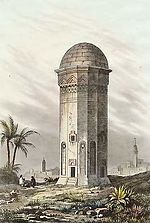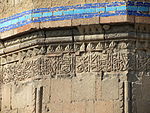Kara Kojunlu
| Kara Kojunlu Qara Qoyunlu Turci Crnog Ovna | |||
|---|---|---|---|
 Turkmeni Crnog Ovna u periodu najveće moći (1407-1468). | |||
| Geografija | |||
| Kontinent | Azija | ||
| Regija | Bliski istok | ||
| Zemlja | Azerbejdžan, Gruzija, Jermenija, Iran, Turska, Irak | ||
| Glavni grad | |||
| Društvo | |||
| Službeni jezik | turski (neslužbeno su korišteni azerbejdžanski[2] (poezija)[3][3], persijski[4] (poezija)[3], i arapski[5]) | ||
| Religija | islam | ||
| Politika | |||
| Oblik države | monarhija | ||
| Istorija | |||
| — Osnivanje | 1374. | ||
| — Ukidanje | 1468. | ||
| Geografske i druge karakteristike | |||
| Valuta | akča[6] tanka[6] | ||
| Zemlje prethodnice i naslednice | |||
| Prethodnice: | Naslednice: | ||
Kara Kojunlu (tur. Qara Qoyunlu,pers. قره قویونلو; pers. قره قویونلو), poznati i kao Turkmeni Crnog Ovna, bili su muslimanska monarhija Turaka Oguza,[7][8][9] koja je u periodu od 1374. do 1468. vladala teritorijom današnjeg Azerbejdžana, Gruzije, Jermenije, severozapadnog Irana, istočne Turske i severoistočnog Iraka.[10][11][12][13]
Istorija[uredi | uredi izvor]
Prva država Turkmena Crnog Ovna bio je Herat u današnjem Avganistanu.[14] Od 1375. bili su vazali sultana u Bagdadu, od kojih se otcepio Kara Jusuf (1388-1420) zavladavši Mosulom i Tabrizom. Pokorio ih je Tamerlan 1400, ali je Kara Jusuf izbegao u Egipat i uz pomoć Mameluka povratio Tabriz oko 1406, a 1410. zauzeo je Bagdad. Posle njegove smrti (1420), država je postepeno opadala zbog unutrašnjih sukoba i pobuna u Jermeniji. Jahan Šah (1438-67) privremeno je obnovio državu Crnog Ovna, ali je katastrofalno poražen u ratu sa Uzun Hasanom od Ak Kojunlua, koji je 1468. pripojio Kara Kojunlu.[15]
Poreklo[uredi | uredi izvor]
Vladajuća porodica je poticala iz plemena Jiva turaka Oguza, tačnije, Baharla,[16] koji su do četrnaestog veka posedovali teritorije severno od jezera Van i Mosula u gornjoj Mesopotamiji.[17] Plemena koja su činila Kara Kojunlu pored Baharlua bila su Sadlu, Karamanlu, Alpaut, Dukarlu, Džagirlu, Hadžilu, Agačeri.[18] Prema Faruku Sumeru, pleme Kara Kojunlu je nesumnjivo bilo podplemene (oba) Oguza, a tvrdnja Minorskog da je ovo podpleme pripadalo Jivama je verovatno tačna.[19]
Duharlu Turkmeni, ogranak Kara Kojunlua, prvi put se pojavio u Hronici Mihajla Panaretosa. Pretpostavlja se da je pleme Duharlu došlo u Anadoliju iz centralne Azije tokom mongolskih invazija, o čemu svedoči legendarna tradicija Kara Kojunlua.[20]
Uspon[uredi | uredi izvor]
Godine 1400, Timuridsko carstvo pod Timurom je porazilo Kara Kojunlu, a Kara Jusuf je pobegao u Egipat, tražeći utočište kod Mamelučkog sultanata. Kara Jusufa je dočekao šeik Mahmud, navab Damaska. Nedugo zatim u Damask je došao i džalairidski sultan Ahmad Džalajir. Ne želeći da pogorša odnose sa Timurom, an-Nasir Faradž je pristao da uhapsi Kara Jusufa i Ahmada Džalajira i da ih izruči. Zajedno u zatvoru, dvojica lidera su obnovila svoje prijateljstvo, postigvši dogovor da Ahmad Džalajir zadrži Bagdad, a Kara Jusuf Azerbejdžan. Ahmad je takođe usvojio Kara Jusufovog sina Pirbudaga. Kada je Timur umro 1405. godine, an-Nasir Faradž ih je obojicu pustio. Međutim, prema Faruku Sumeru, oni su pušteni na slobodu po naređenju pobunjenog valija iz Damaska, Šejha Mahmuda.[21][22][23][24]
Religija[uredi | uredi izvor]
Prema R. Kviring-Zoče u Enciklopedija Iranika:
Argument da je postojao jasan kontrast između sunizma Ak Kojunla i šiizma Kara Kojunla i Safavija počiva uglavnom na kasnijim safavidskim izvorima i mora se smatrati dvojbenim.[25]
K. E. Bosvort u delu Nove islamske dinastije navodi:
Što se tiče verskih pripadnosti Kara Kojunla, iako su neki od kasnijih članova porodice imali šiitska imena i povremeno su postojali šiitski natpisi na kovanicama, nema snažnih dokaza za definitivne šiitske simpatije među mnogim Turkmenskim elementima tog vremena.[26]
Galerija[uredi | uredi izvor]
-
Erivanski toranj, 1838
-
Groblje u Argavandu, fragment na arapskom
-
Groblje u Argavandu, fragment na arapskom
Reference[uredi | uredi izvor]
- ^ a b Faruk Sümer (1988—2016). „KARAKOYUNLULAR Doğu Anadolu, Azerbaycan, İran ve Irak'ta hüküm süren Türkmen hânedanı (1351-1469).”. TDV Encyclopedia of Islam (44+2 vols.) (na jeziku: Turkish). Istanbul: Turkiye Diyanet Foundation, Centre for Islamic Studies.
- ^ Faruk Sümer (1992). „Başlangıçtan Cihan-Şah'a Kadar”. Kara Koyunlular (na jeziku: turski). 1. Turkish Historical Society. str. 8. ISBN 9789751748478.
- ^ a b v Minorsky 1954, str. 283.
- ^ Arjomand 2016, str. 11.
- ^ Bauden 2019, str. 423.
- ^ a b „Coins from the tribal federation of Qara Qoyunlu – Numista”. en.numista.com.
- ^ Philippe, Beaujard (2019). „Western Asia: Revival of the Persian Gulf”. The Worlds of the Indian Ocean. Cambridge University Press. str. 515—521. ISBN 9781108341219. "In a state of demographic stagnation or downturn, the region was an easy prey for nomadic Turkmen. The Turkmen, however, never managed to build strong states, owing to a lack of sedentary populations (Martinez-Gros 2009: 643). When Tamerlane died in 1405, the Jalāyerid sultan Ahmad, who had fled Iraq, came back to Baghdad. Five years later, he died in Tabriz (1410) in a battle led against the Turkmen Kara Koyunlu ("[Those of the] Black Sheep"), who took Baghdad in 1412."
- ^ „Kara Koyunlu”. Encyclopaedia Britannica. "Kara Koyunlu, also spelled Qara Qoyunlu, Turkish Karakoyunlular, English Black Sheep, Turkmen tribal federation that ruled Azerbaijan, Armenia, and Iraq from about 1375 to 1468."
- ^ The Book of Dede Korkut
 (F.Sumer, A.Uysal, W.Walker izd.). University of Texas Press. 1972. str. Introduction. ISBN 0-292-70787-8. "Better known as Turkomans... the interim Ak-Koyunlu and Karakoyunlu dynasties..."
(F.Sumer, A.Uysal, W.Walker izd.). University of Texas Press. 1972. str. Introduction. ISBN 0-292-70787-8. "Better known as Turkomans... the interim Ak-Koyunlu and Karakoyunlu dynasties..."
- ^ Hovanissian 2004, str. 4.
- ^ Encyclopædia Britannica. "Kara Koyunlu". Online Edition, 2007
- ^ Kouymjian 2004, str. 4.
- ^ „Kara Koyunlu | History, Meaning, & Capital | Britannica”. www.britannica.com.
- ^ Clawson, Patrick (2005). Eternal Iran. Palgrave Macmillan. str. 23. ISBN 978-1-4039-6276-8.
- ^ Stearns, Peter N.; Leonard, William (2001). The Encyclopedia of World History. Houghton Muffin Books. str. 122. ISBN 978-0-395-65237-4.
- ^ Peter B. Golden (1992). An Introduction to the History of the Turkic Peoples. str. 367—368.
- ^ Clifford Edmund Bosworth (2004). The New Islamic Dynasties: A Chronological and Genealogical Manual. Edinburgh University Press. str. 273—274. ISBN 978-0-7486-2137-8. OCLC 1001660530. „Their ruling family seems to have come from the Yïwa or Iwa clan of the Oghuz, and the seats of their power in the fourteenth century lay to the north of Lake Van and in the Mosul region of northern Iraq.”
- ^ Miklukho-Maklay, N. D. Shiism and its social face in Iran at the turn of the XV-XVI centuries "These tribes, which later became known as the Qizilbash tribes... created the states of Kara Koyunlu and Ak Koyunlu, which in the 15th century successively ruled Azerbaijan and most of Iran."
- ^ Sümer, F. (30. 5. 2021). „Ḳarā-Ḳoyunlu”. Ur.: P. Bearman; Th. Bianquis; C.E. Bosworth; E. van Donzel; W.P. Heinrichs. Encyclopaedia of Islam (2nd izd.).
- ^ Rustam Shukurov (2016). The Byzantine Turks, 1204-1461. str. 289.
- ^ Muir, William (1986). Mameluke Or Slave Dynasty Of Egypt. Nabu Press. ISBN 978-1142162863.
- ^ „KARAKOYUNLULAR - TDV İslâm Ansiklopedisi”. TDV İslam Ansiklopedisi (na jeziku: turski). Pristupljeno 2022-04-07.
- ^ „Kara Koyunlu | History, Meaning, & Capital | Britannica”. www.britannica.com (na jeziku: engleski). Pristupljeno 2022-04-07.
- ^ Shahmoradi, Seyyed; Moradian, Mostafa; Montazerolghaem, Asghar (2013). „The Religion of the Kara Koyunlu Dynasty: An Analysis”. Asian Culture and History. 5 (2). doi:10.5539/ach.v5n2p95
 .
.
- ^ Quiring-Zoche 2009.
- ^ Bosworth 1996, str. 274.
Literatura[uredi | uredi izvor]
- Stearns, Peter N.; Leonard, William (2001). The Encyclopedia of World History. Houghton Muffin Books. str. 122. ISBN 978-0-395-65237-4.
- Bosworth, Clifford E. (1996). The New Islamic Dynasties. Columbia University Press.
- Kouymjian, Dickran (2004). „Armenia from the fall of the Cilician Kingdom (1375) to the forced emigration under Shah Abbas”. Ur.: Hovannisian, Richard G. The Armenian People From Ancient to Modern Times, Volume I: The Dynastic Periods: From Antiquity to the Fourteenth Century. Palgrave Macmillan. ISBN 978-1-4039-6421-2.
- Minorsky, V. (1954). „Jihān-Shāh Qara-Qoyunlu and His Poetry (Turkmenica, 9)”. Bulletin of the School of Oriental and African Studies. 16 (2): 271—97. JSTOR 609169. doi:10.1017/s0041977x00105981.
- Khachikyan, Levon. ԺԵ դարի հայերեն ձեռագրերի հիշատակարաններ, մաս 1 (Fifteenth Century Armenian Colophons, Part 1). Yerevan, 1955.
- Morby, John. The Oxford Dynasties of the World, 2002.
- Sanjian, Avedis K. Colophons of Armenian manuscripts, 1301-1480: A Source for Middle Eastern History, Selected, Translated, and Annotated by Avedis K. Sanjian. Cambridge: Harvard University Press, 1969.
- Shahmoradi, Seyyed; Moradian, Mostafa; Montazerolghaem, Asghar (2013). „The Religion of the Kara Koyunlu Dynasty: An Analysis”. Asian Culture and History Archives. 5 (2). doi:10.5539/ach.v5n2p95.
- Arjomand, Saïd Amir (2016). „Unity of the Persianate World under Turko-Mongolian Domination and Divergent Development of Imperial Autocracies in the Sixteenth Century”. Journal of Persianate Studies. 9 (1): 11. doi:10.1163/18747167-12341292. „The disintegration of Timur's empire into a growing number of Timurid principalities ruled by his sons and grandsons allowed the remarkable rebound of the Ottomans and their westward conquest of Byzantium as well as the rise of rival Turko-Mongolian nomadic empires of the Aq Qoyunlu and Qara Qoyunlu in western Iran, Iraq, and eastern Anatolia. In all of these nomadic empires, however, Persian remained the official court language and the Persianate ideal of kingship prevailed.”
- Bauden, Frédéric (2019). „Diplomatic Entanglements between Tabriz, Cairo, and Herat: a Reconstructed Qara Qoyunlu Letter Datable to 818/1415”. Ur.: Bauden, Frédéric; Dekkiche, Malika. Mamluk Cairo, a Crossroads for Embassies:Studies on Diplomacy and Diplomatics. Brill.
- Kadoi, Yuka (2019). Persian Art: Image-making in Eurasia. Edinburgh University Press.
- Lugal, Necati; Sümer, Faruk (2002). „KİTÂB-ı DİYARBEKRİYYE”. İslâm Ansıklopedısı.
- Price, Massoume (2005). Iran's Diverse Peoples: A Reference Sourcebook. ABC-CLIO.
- Quiring-Zoche, R. (2009-10-29). „AQ QOYUNLŪ”. Encyclopedia Iranica.
- Quiring-Zoche, R. (1986). „Āq Qoyunlū”. Encyclopædia Iranica, online edition, Vol. II, Fasc. 2. New York. str. 163—168.
- Roemer, H. R. (1986). „The Turkmen dynasties”. Ur.: Lockhart, Laurence; Jackson, Peter. The Cambridge History of Iran, Volume 6: The Timurid and Safavid Periods. Cambridge: Cambridge University Press. ISBN 0-521-20094-6.
- Roy, Kaushik (2014). Military Transition in Early Modern Asia, 1400-1750. Bloomsbury. „Post-Mongol Persia and Iraq were ruled by two tribal confederations: Akkoyunlu (White Sheep) (1378–1507) and Qaraoyunlu (Black Sheep). They were Persianate Turkoman Confederations of Anatolia (Asia Minor) and Azerbaijan.''”
- Savory, R. M. (2009). „The Struggle for Supremacy in Persia after the death of Tīmūr”. Der Islam. De Gruyter. 40: 35—65. S2CID 162340735. doi:10.1515/islm.1964.40.1.35.
- Shukurov, Rustam. The Byzantine Turks 1204-1461. Brill, 2016.



